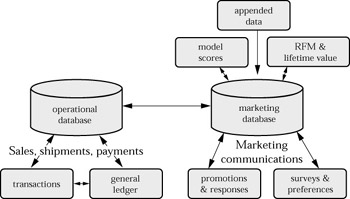Two Kinds of Databases
|
There are really two different kinds of databases in any company that is engaged in direct marketing of products and services. One is an operational database, and the other is a marketing database (see Figure 1-2).

Figure 1-2: Operational and Marketing Databases
An operational database is used to process transactions and get out the monthly statements.
-
For a cataloger, the operational database is used to process the orders, charge the credit cards, arrange shipment, and handle returns and credits.
-
For a bank, the operational database processes checks and deposits, maintains balances, and creates the monthly statements.
-
For a telephone company, the operational database keeps track of the telephone calls made and arranges the billing for them.
A marketing database gets data from the operational database, if there is one. These data consist of a summary of monthly transactions. But the marketing database also includes much more. It gets additional data from
-
Preferences and profiles provided by the customers
-
Promotion and response history from marketing campaigns
-
External sources, such as Experian, Donnelly, and Claritas
-
Lifetime value and RFM analysis, leading to creation of customer segments
-
Modeling for churn and next best product
The marketing database passes data back to the operational database. It may advise the operational database
-
The segment that each customer has been placed in, which may lead to operational decisions. Gold customers, for example, may get different operational treatment.
-
Expressed customer preferences, which lead to different operational treatment; e.g., smoking or nonsmoking rooms are assigned automatically.
The operational database is run by IT. It is run on accounting principles, and it balances to the penny, since there are legal and tax aspects to its data. It is audited by external auditors. It contains only current data on customers. Old data are archived. There are no data on prospects until they make a purchase.
The marketing database is managed by the marketing department. It is usually outsourced. It is not run on accounting principles, and it does not need to balance. There are few legal or tax considerations. It contains information on current customers, prospects, and lapsed customers and communications with them. It may retain data stretching back over a period of several years.
A data warehouse combines all the data and functions of both an operational database and a marketing database (plus, in many cases, other functions such as employee data, payroll, product data, production data, etc.) in one huge database. The data warehouse is so big and complicated that it needs to be managed by a committee. It is often very expensive to build and maintain. It is seldom very flexible. Marketing priorities usually get short shrift in a data warehouse, as other priorities are often given preference.
|
EAN: 2147483647
Pages: 226